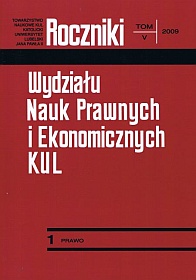The Principle of Separation and Balance of Powers in the Polish Constitutional Law. A Historical View and in the Constitution of the Republic of Poland of 1997
Abstract
In the 18th century, the doctrine of separation of powers was established as a remedy for tyranny . It is Montesquieu who is commonly regarded as the founder of the classic doctrine of separation and balance of powers. Later, attempts to create more of less original models were also made. It should be noticed that the reception of the principle of separation and balance of powers in Poland was very fast, relative to its formulation. This happened together with the establishment of the Third of May Constitution. Unfortunately, that Constitution was quickly abolished and Poland disappeared from the map of Europe for 123 years. The revived state – the Second Republic of Poland – had two constitutions let alone provisional acts of constitutional rank. The first, March Constitution directly referred to the principle of separation of powers. The other, April Constitution was a contradiction of the former. The political system of the Second Republic of Poland in the years 1935-1939 was called authoritarian. The April Constitution directly speaks of a uniform authority of the state. PRL principally had one constitution (1952) – but we have to remember about its amendments of 1976. The political system of PRL was without any doubt a totalitarian one. The Third Republic of Poland returned to the system based on the separation of powers even before its own constitution was passed (1997). Hence, despite attempts to tear the Polish State off the principle of separation of powers, its perception in the society and attachment to it were so strong and permanent that Poland, especially in the periods when it regained full sovereignty, quickly returned to building its political system basing on this very principle.
The constitution of 1997 states explicitly that the Polish state system is based on the division and balance of powers: legislative (exercised by the Sejm and Senate), executive (exercised by the President and the Council of Ministers) and judiciary (exercised by the courts and tribunals) (Article 10 Section 1 and 2.)
The Constitutional Tribunal, in its ruling of 1994, stated that the separation of powers cannot be regarded as a separation in the case of the relationship between the legislative and executive powers. This is different for the relationship between the judiciary and other authorities (legislative and executive). Here the separation is obligatory . The concept of the essence of individual powers assumes that there exists a sort of competence core of legislative, executive and judiciary powers. The core cannot be entered by the other powers, because it would mean violating the principle of separation of powers. It is true that acts may transfer specific powers between the powers, but the intrusion into the field belonging to another power cannot be too deep, because such a legal normalization would violate the constitutional principle of the separation of powers. The principle of separation and balance of powers involves a system of checks and balances or a system of mutual restraint and balancing of powers. L. Garlicki writes that there are two basic models of the relationship between the legislative and the executive: the parliamentary one (parliamentary-cabinet) and the presidential one. The Constitution of Poland of 1997 preserved the parliamentary system of government in Poland. Art 10 Section 1 of the Constitution of Poland of 1997 provides for the mutual balance of relations between the legislative and executive powers, subsequent provisions of the constitution give a far stronger position to the parliament, and within it - to the Sejm. This corresponds to the Polish tradition. L. Garlicki talks of the specificity of the current Polish model.
References
Banaszak B., Prawo konstytucyjne, Warszawa 2008.
Bardach J., Leśnodorski B., Pietrzak M., Historia ustroju i prawa polskiego, Warszawa 2000.
Izdebski H., Historia myśli politycznej i prawnej, Warszawa 2001.
Kelly J. M., Historia zachodniej teorii prawa, Kraków 2006. Monteskiusz, O duchu praw, Kety 1997.
Sarnecki P., Prawo konstytucyjne RP, Warszawa 2008.
Skrzydło W., Konstytucja Rzeczypospolitej Polskiej. Komentarz, Zakamycze 1999.
Zubik M., Konstytucja III RP w tezach orzeczniczych Trybunału Konstytucyjnego i wybranych sadów, Warszawa 2008.
Copyright (c) 2009 Roczniki Wydziału Nauk Prawnych i Ekonomicznych KUL

This work is licensed under a Creative Commons Attribution-NonCommercial-NoDerivatives 4.0 International License.

